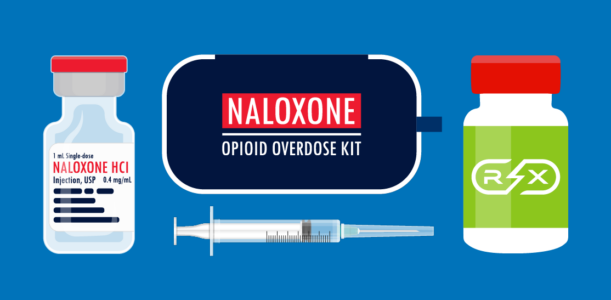Naloxone: The Overdose Treatment to Supplement Your Preventative Care
May 4, 2023 | Pharmaceutical Waste Disposal

What is Naloxone?
Naloxone is the generic name for an opioid medication that is used to reverse an opioid overdose. It is an opioid antagonist—meaning that it binds to opioid receptors and can reverse and block the effects of other opioids. Click here to brush up on opioid and addiction definitions. Naloxone can save lives because it can restore normal breathing in the event of an opioid overdose, as it will force the body to wake up and keep breathing.
In the event of an overdose, Naloxone temporarily reverses the effects of overdose from drugs made from opium or opioids, including heroin, morphine, oxycodone, methadone, fentanyl and more. Naloxone should be given to anyone who presents signs of overdose, this will help prevent severe breathing issues that can lead to death. Naloxone is only effective with opioids and will not reverse the effects of drugs not classified as an opioid.
Is Naloxone FDA approved?
There are two FDA-approved formulations: injectable meaning administering a liquid into a person’s body with a needle and a syringe, and prepackaged nasal spray meaning delivered locally in the nasal cavities. Naloxone is available in all 50 states.
As of March 29, 2023, the FDA approved an over-the-counter Naloxone Nasal Spray called Narcan. This action leads the way for the life-saving medication to reverse an opioid overdose to be sold directly to consumers in places like drug stores, convenience stores, grocery stores and gas stations, as well as online. The application to approve Narcan nasal spray for OTC use was granted priority review status and was the subject of an advisory committee meeting in February 2023, where committee members voted unanimously to recommend it be approved for marketing without a prescription.
How is Naloxone administered?
Administered when an individual is showing signs of opioid overdose, naloxone is a temporary treatment and its effects do not last long. Naloxone can act as quickly as two to three minutes after administering and works for 30 to 90 minutes, which means it can wear off before the drugs that caused the overdose wears off. You should always call emergency medical services in the event of an overdose even after administering Naloxone.
Can Naloxone be abused?
Naloxone is a safe medicine and has no effect on a person who does not have opioids in their system. Naloxone can be used in every overdose situation. Even if a person has overdosed and used naloxone in the past, it will still be effective. Naloxone is not a controlled substance; it is becoming more and more readily available and accessible.
How are Naloxone and Drug Disposal related?
Naloxone is reactive care to the Opioid Epidemic. While it is crucial in the epidemic, we find ourselves in, we can’t think of it as the only solution. We need to provide both preventative and reactive tools for opioids.
As the opioid epidemic continues to be an issue, as a community, we must take an evidence-based approach to saving lives. In 2021, 107,662 lives were lost in the US due to a drug overdose, and 66% of those deaths were from opioid overdoses. There are many ways opioids can enter a community – stolen from a pharmacy, sold, and bought online, through fraudulent prescriptions, and more. Opioids aren’t always obtained illegally; an opioid can enter a community through a legal prescription that was then diverted for misuse.
By having Naloxone, you are more likely to prevent an opioid related overdose death. By having proper drug disposal such as Rx Destroyer, opioids can be disposed of and deemed irretrievable in minutes to prevent further misuse and overdoses. Be sure to keep any prescription drugs secure and locked away, and if you find yourself having unwanted medications, put them in Rx Destroyer immediately to prevent the drugs from falling into the wrong hands. To help curb this epidemic, you can invest in your community’s future by having Naloxone and Rx Destroyer.

